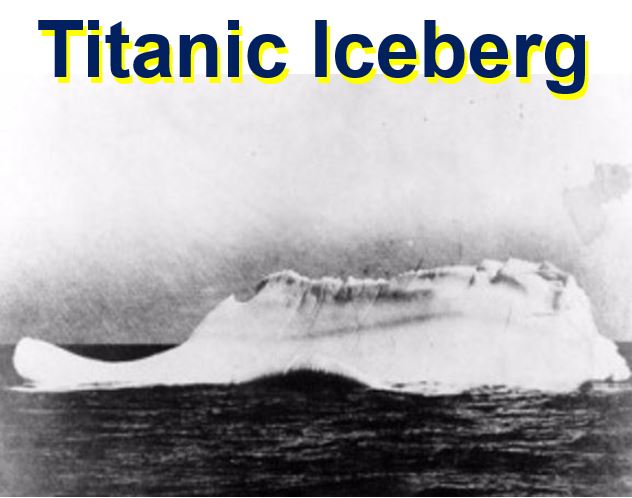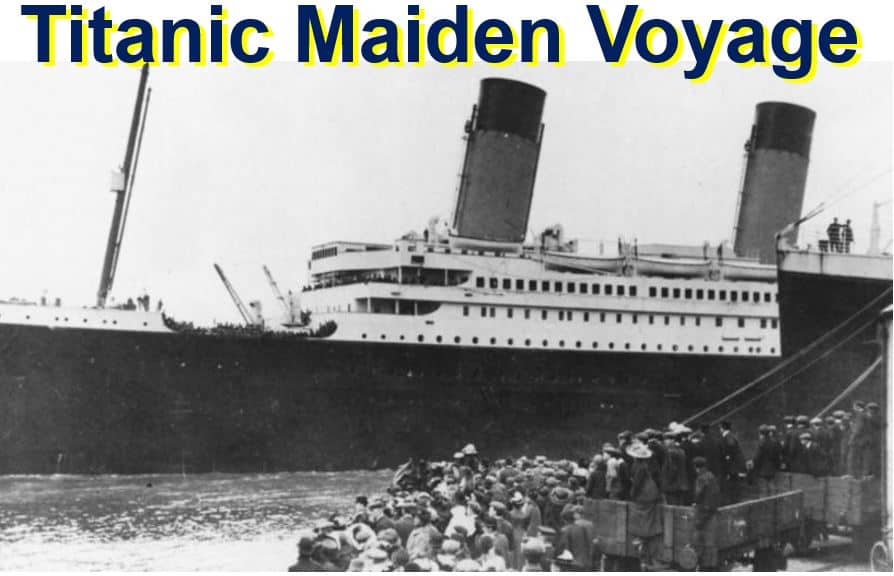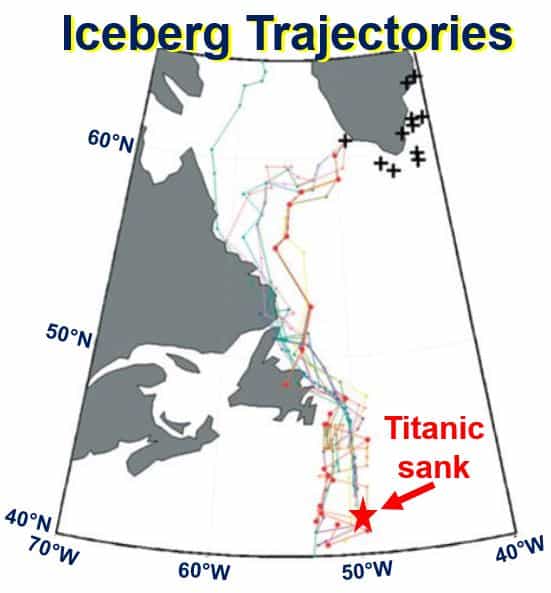RMS Titanic, the British passenger liner that sank in 1912, hit a mega iceberg 100000 years old, says Professor Grant Bigg from the University of Sheffield, who also used computer modelling to work out where the lethal iceberg was born and how big it was.
During a talk on Friday, 18th March, 6 to 7pm, at the Cambridge Science Festival, Prof. Bigg will explain what he believes happened on that tragic morning of 15 April 1912, when over 1,500 people died.
Most of us know that the Titanic was a passenger liner on her maiden voyage that sank after hitting an iceberg. However, not much was ever known about the iceberg that hit it.
 Photograph of the iceberg that is believed to the the one that sank the Titanic. It had some red paint marks across it and was in the location of the vessel’s distress calls. (Image: ultimatetitanic.com)
Photograph of the iceberg that is believed to the the one that sank the Titanic. It had some red paint marks across it and was in the location of the vessel’s distress calls. (Image: ultimatetitanic.com)
Iceberg made of 100,000-year-old snow
During his presentation, Prof. Bigg, Professor in Earth Systems Science at Sheffield University’s Department of Geography, will explain what happened to two individual icebergs, including the famous one that sank the ship.
Prof. Bigg believes the iceberg was formed from 100,000 year-old snow. In order to make his calculations, he used observations taken in 1912 and added modern data about ocean currents and winds.
Iceberg came from southwest Greenland
These suggested that the giant iceberg came from a cluster of glaciers in southwest Greenland.
Regarding the iceberg’s origin, Prof. Bigg said:
“We have a computer model for calculating the paths of icebergs in any given year. We take what we know about ocean currents, then add meteorological readings for that year to calculate prevailing winds.”
 The Titanic departing on her maiden voyage from Southampton on April 10, 1912. Friends and family waving goodbye to passengers – most of them would never see each other again. The ship, which was believed to be ‘unsinkable’, only had enough lifeboats to carry about half of those on board. (Image: titanicuniverse.com)
The Titanic departing on her maiden voyage from Southampton on April 10, 1912. Friends and family waving goodbye to passengers – most of them would never see each other again. The ship, which was believed to be ‘unsinkable’, only had enough lifeboats to carry about half of those on board. (Image: titanicuniverse.com)
“Applying those techniques to 1912 points to the iceberg coming from around Qassimiut on Greenland’s southwest coast.”
Iceberg was colossal when it started off
Prof. Bigg also discovered that when the iceberg first broke off and started to drift it was huge.
When the Titanic, the largest vessel in the world at that time, sank, the iceberg was believed to have been 400 feet long and about 100 feet above the water, which would have given it a mass of 1.5 million tonnes.
However, it crashed into the Titanic at a latitude of 41 degrees north – a point further south than Cornwall. It had travelled a long way from Greenland, and had been melting for months before the collision.
Prof. Bigg estimates that the iceberg started off as a 1,700 foot long frozen goliath with a mass of 75 million tonnes.
Theories regarding disaster put on ice
Over the past 100 years, historians have said that the seas which sank the famous passenger liner had an abnormally high number of icebergs that year, caused by solar or lunar effects.
 Trajectories of representative modelled icebergs reaching the area (south of 44°N and west of 50°W) of the sinking of the Titanic between January and July 1912. (Image: sheffield.ac.uk)
Trajectories of representative modelled icebergs reaching the area (south of 44°N and west of 50°W) of the sinking of the Titanic between January and July 1912. (Image: sheffield.ac.uk)
However, researchers from Sheffield University have shown that the vessel had not been that unlucky. Using data on iceberg locations dating back to that fateful year – recorded to help prevent another Titanic tragedy – they showed that 1912 did have a higher-than-average number of icebergs, but it was definitely not an extreme year.
Study leader, Prof. Bigg, said:
“We have seen that 1912 was a year of raised iceberg hazard, but not exceptionally so in the long term. 1909 recorded a slightly higher number of icebergs and more recently the risk has been much greater – between 1991 and 2000 eight of the ten years recorded more than 700 icebergs and five exceeded the 1912 total.”
“As use of the Arctic, in particular, increases in the future with the declining sea-ice the ice hazard will increase in water not previously used for shipping. As polar ice sheets are increasingly losing mass as well, the iceberg risk is likely to increase in the future, rather than decline.”
 News of the tragic sinking and loss of life shocked people on both sides of the Atlantic. (Images: (Left) Wikipedia. (Right) historicjoplin.org)
News of the tragic sinking and loss of life shocked people on both sides of the Atlantic. (Images: (Left) Wikipedia. (Right) historicjoplin.org)
The iceberg which sealed the fate of the 1,517 passengers, was spotted just before midnight on 14th April, 500 metres away. Despite a rapid response to slow the ship, it was not enough and the liner sank in less than two and a half hours. Only 700 people survived.
The research, which was published in the journal Weather, was funded by the National Environment Research Council (NERC).
Iceberg threat for ships growing
Prof. Bigg also explains how icebergs continue to be a threat to ships today. The cruise ship Explorer hit an iceberg in Antarctica’s Weddell Sea in 2007 and sank.
The iceberg threat will grow as the number of ships travelling through the north Atlantic increases. Prof. Bigg said that in 2014, a total of 1,500 vessels were recorded navigating in the north Atlantic shipping areas. He added that traffic will continue growing at a very past pace.
Video – Did the Titanic have a fatal flaw?

